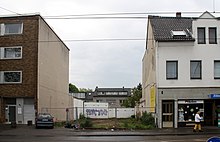In urban planning, infill, or in-fill, is the rededication of land in an urban environment, usually open-space, to new construction.[1] Infill also applies, within an urban polity, to construction on any undeveloped land that is not on the urban margin. The slightly broader term "land recycling" is sometimes used instead. Infill has been promoted as an economical use of existing infrastructure and a remedy for urban sprawl.[2] Detractors view increased urban density as overloading urban services, including increased traffic congestion and pollution, and decreasing urban green-space.[3][4] Many also dislike it for social and historical reasons, partly due to its unproven effects and its similarity with gentrification.[5]

In the urban planning and development industries, infill has been defined as the use of land within a built-up area for further construction, especially as part of a community redevelopment or growth management program or as part of smart growth.[6][7]
It focuses on the reuse and repositioning of obsolete or underutilized buildings and sites.[8]
Urban infill projects can also be considered as a means of sustainable land development close to a city's urban core.
Redevelopment or land recycling are broad terms which include redevelopment of previously developed land. Infill development more specifically describes buildings that are constructed on vacant or underused property or between existing buildings.[9] Terms describing types of redevelopment that do not involve using vacant land should not be confused with infill development. Infill development is commonly misunderstood to be gentrification, which is a different form of redevelopment.[5]
- ^ Alfirevic Dj., Simonovic Alfirevic S. (2015) Infill Architecture: Design Approaches for In-Between Buildings and 'Bond' as Integrative Element. Arhitektura i urbanizam 41: 24–31.
- ^ Brooks, Nancy; Donaghy, Kieran; Knaap, Gerrit-Jan (2011). "Introduction". In Brooks, Nancy; Donaghy, Kieran; Knaap, Gerrit-Jan (eds.). The Oxford Handbook of Urban Economics and Planning. New York: Oxford University Press. p. 7. ISBN 978-0-19-538062-0.
- ^ McConnell, Virginia; Wiley, Keith (2011). "Part IV: Urban Land-Use and Transportation Policy, Chapter 21: Infill Development: Perspectives and Evidence from Economics and Planning". In Brooks, Nancy; Donaghy, Kieran; Knaap, Gerrit-Jan (eds.). The Oxford Handbook of Urban Economics and Planning. New York: Oxford University Press. pp. 473–502. doi:10.1093/oxfordhb/9780195380620.013.0022. ISBN 978-0-19-538062-0.
- ^ Houck, Michael C. (2010). "Chapter 5: In livable cities is preservation of the wild: the politics of providing for nature in cities". In Douglas, Ian; et al. (eds.). The Routledge Handbook of Urban Ecology. Abingdon, Oxfordshire, England: Routledge. pp. 48–62. ISBN 978-0-415-49813-5. Note: The odd grammar of the title is based on a quotation from Henry David Thoreau.
- ^ a b Cite error: The named reference
:0was invoked but never defined (see the help page). - ^ Dunphy, Robert (2005). "Smart Transportation and Land Use: the New American Dream". Smart Growth and Transportation: Issues and Lessons Learned. Conference proceedings, Transportation Research Board, volume 32). Washington, D.C.: Transportation Research Board of the National Academies. p. 126.
- ^ McConnell, Virginia; Wiley, Keith (12 January 2012). "Infill Development: Perspectives and Evidence from Economics and Planning". In Brooks, Nancy; Donaghy, Kieran; Knaap, Gerrit-Jan (eds.). The Oxford Handbook of Urban Economics and Planning. OUP USA. p. 474. ISBN 978-0-19-538062-0.
- ^ "Infill Philadelphia". Community Design Collaborative. Archived from the original on 15 July 2007. Retrieved 13 November 2007.
- ^ The Southeast Tennessee Green Infrastructure Handbook (PDF). Chattanooga, Tennessee: Southeast Tennessee Development District. 2011. p. 13. Archived from the original (PDF) on 20 March 2012.